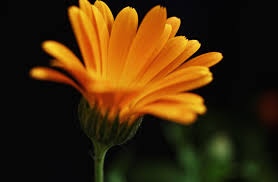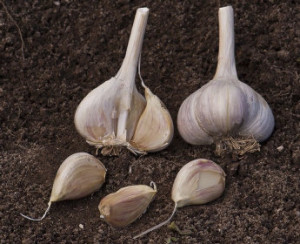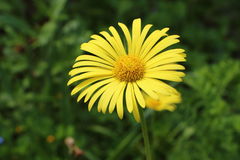I’m continuing my three-part series on starting your herbal garden. I need to mention here that my assumption, again, is that you’ve done your research and have prepared your soil for planting. So many problems with plants can be avoided by feeding your soil and ensuring drainage is adequate and biological soil life is thriving!
Truthfully I have a really tough time narrowing it down to just 9 because so many plants are useful to have in your medicinal arsenal. However, one of the criteria I am looking for is ease of growing, which does slim down the list, and the ones I believe are most helpful for family medical care.
Last time I covered Lemon balm, Chamomile, and Echinacea. This time I will cover calendula, Garlic, and Arnica. Three very different plants but all great for a home medical kit.

Calendula officinalis (Pot Marigold)
This sunny, happy, orange or yellow flowered plant is part of the Asteraceae family. Not to be mistaken for the marigold in the Tagetes family. Sadly, it is an annual (I always prefer perennials), but with all its many benefits I still think it earns a place in every medicinal garden.
Propagate
Calendula does best when direct sown into the soil once the last chance of frost has past. You can start them inside and transplant but there is more chance of harming the taproot. Make sure your soil allows for adequate drainage and oxygen, especially during the beginning stages, to avoid “damping off.”Calendula will tolerate a wide range of soils but prefers full sun.
A little tip
If you pick the mature flowers regularly in the spring and summer it may continue producing more flowers, even into the fall. Picking flowers also reduces the chance of pests (blister beetles, cucumber beetles, and aphids). Never let the flowers go to seed or you will greatly decrease your harvest.
Harvesting
The best time to pick is in the heat of the day when the water content is the lowest. Dry the flowers as soon as possible. The petals dry quickly but the receptacle does not so you can expect a total drying time of 10 days or more at 90 degrees or so. Let them cool and sort them carefully when they finish drying, as they reabsorb moisture readily.
Uses
Calendula is a wonderful anti-inflammatory for the skin and is used in many lotions, creams and salves. Apply topically for skin irritation: dry skin, cracked nipples, eczema, wounds.
Taken internally it will help the digestive system: colitis, peptic ulcers, gastritis (infusion) and is cleansing for the liver and gall bladder (tincture). It also helps reduce menstrual pain and regulate bleeding (infusion).
Preparations: tincture, infusion, salve, cream, compress
TYPE: Annual
SOIL: Well-drained, aerated soil
SUN: Prefers full sun, will tolerate partial shade
WATER: Water well 1-2 times a week
Allium (garlic)
 You can’t go wrong with garlic. It adds a wonderful, flavorful explosion to any fare and, if used correctly, can add nutritional benefits. Garlic is also a wonderful addition to your garden as a pest repellant.
You can’t go wrong with garlic. It adds a wonderful, flavorful explosion to any fare and, if used correctly, can add nutritional benefits. Garlic is also a wonderful addition to your garden as a pest repellant.
Propagate
Garlic can be planted in the spring but you will likely deal with smaller bulbs when harvesting. I recommend planting in the fall, so put this on your list as something to do as you move into fall. You’ll want to plant garlic about a month before frost hits. Simply break apart the bulb a few days before planting but keep the husk on the individual cloves. Plant them with the pointy end up about 2” deep and 4” apart. Heavily cover with mulch. In the spring green shoots will begin emerging. As threat of frost is gone, feel free to remove mulch.
A little tip
Do NOT use garlic bought at the store, use garlic from a previous harvest or buy them from a local garden shop. Be aware that you need to pick a variety that is good for your zone. Garlic flowers are lovely but if you are looking for larger bulbs, clip back any flower shoots. Because garlic likes extra nitrogen, fertilizing with rabbit manure or manure tea would give it that added boost. Water well about every 3-5 days during the drier season.
Harvesting
Harvest when you see the tops begin to yellow and get droopy (usually late summer in my area). Pull them from the soil gently, using a spade, brush off the dirt and hang in a shady spot with plenty of air flow. You can bunch them together but make sure every side gets air. It is ready to use when the wrappers are dry and papery. You can either “braid” them (yes, even hardneck garlic which is what grows best here) or clip off the tops and store in a dry, cool area.
Uses
Garlic is one of those things that mainstream medicine has recognized. There’s really no way you can go wrong adding garlic to your life on a daily basis.
- Reduce risk of certain cancers
- Positive effects on the cardiovascular system
- Lower cholesterol
- Antibacterial
- Antimicrobial
- Antiviral
- Antifungal
The key to achieving the highest health benefits from this powerhouse is to make sure you don’t cook it, yes, add it to dishes, but try to add it near the end of cooking, it will provide the most intense flavor and won’t destroy all the enzymes (allicin). Press the garlic through a garlic press (this is the one I use) and let it stand for 5-10 minutes, this activates the allicin. At this point you can add it to your dish, blend it with some honey and spread it on toast, add it to a batch of elderberry syrup (already prepared) for an extra immune boost, or, get crazy and just eat it straight up. Warning – you will have garlic breath
Preparations: capsules, food, infused oil, powder
TYPE: Annual
SOIL: Well-drained, aerated soil
SUN: Prefers full sun
WATER: Water well every 3-5 days during the hot, dry months
Warning
In large doses garlic can be aggravating to some people, in normal doses it promotes good micro flora in the gut.
Arnica
 A daisy-like flower with a happy, sunny disposition also part of the Asteraceae family. This is a beautiful and helpful addition to any medicinal herb garden.
A daisy-like flower with a happy, sunny disposition also part of the Asteraceae family. This is a beautiful and helpful addition to any medicinal herb garden.
Propagate
If you are fortunate enough to know someone that has arnica in their garden, ask if you can have a cutting or if they are ready to divide their plant. If not, starting with seeds isn’t that difficult but germination can be tricky taking one month up to two years so patience will come into play here! Sprinkle the seeds and lightly cover with soil. Keep moist. The other option is to start them indoors with plenty of light (preferably a grow light) you can transplant these in the spring after threat of frost is gone.
Uses
- anti-inflammatory
- analgesic (reduces pain)
- vulnerary (wound-healing: fractures, sprains, contusions, muscular pain, varicose veins)
- rubifacient (increases blood flow to an area helping speed healing)
Arnica should only be used topically on unbroken skin as a poultice, in a carrier oil or salve.
Harvesting
Harvest blooming flower heads in summer, June through August.
Preparations: poultice, salve, infused oil, wash ( Steep 2 teaspoons arnica in 1 cup boiling water, let cool and use)
TYPE: Perennial
SOIL: Prefers sandy, slightly alkaline
SUN: Prefers full sun, will tolerate shade in very hot areas
WATER: Not drought tolerant until established, keep soil moist but not soaked – a good weekly watering should suffice except during very dry, hot months
This is for educational purposes only, it is NOT medical advice




Leave a Reply
You must be logged in to post a comment.